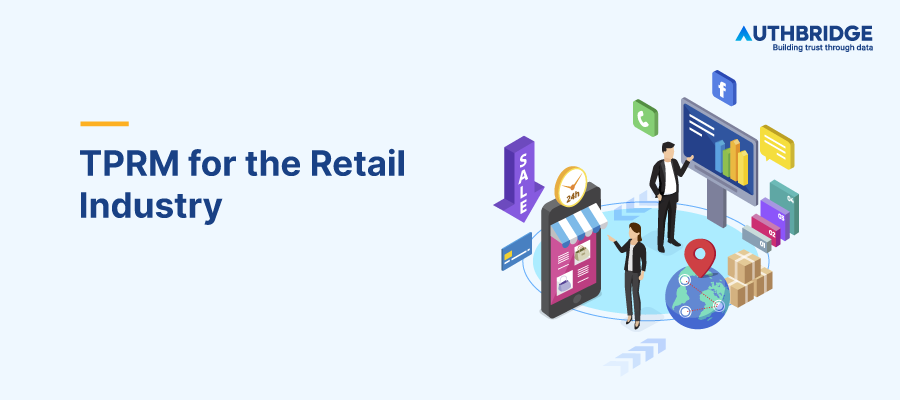Introduction
In the fast-paced world of retail, managing third-party risks is not just a necessity but a strategic imperative, especially in a vibrant and diverse market like India. The retail sector, with its intricate supply chains, reliance on technology, and complex vendor networks, faces a multitude of risks that can impact operational efficiency, brand reputation, and customer trust.
The Importance of TPRM in the Retail Sector
For Indian retailers, TPRM is crucial in navigating the challenges of product safety, data security, and logistics. As retail operations expand both online and offline, the potential for risks associated with third-party vendors, cybersecurity threats, and supply chain disruptions grows exponentially. Implementing a robust TPRM framework can mitigate these risks, ensuring the continuity and integrity of retail operations.
Specific Challenges Faced by Indian Retailers
The Indian retail landscape presents unique challenges, including regulatory compliance, diverse consumer demands, and the integration of traditional retail with e-commerce platforms. Additionally, the prevalence of informal markets and the rapid pace of technological adoption further complicate risk management strategies. These factors underscore the need for a comprehensive approach to TPRM that is adaptable to the Indian context.
Vendor Management for Product Safety
Product safety is a cornerstone of consumer trust and loyalty in the retail sector. In India, where the market is vast and diverse, managing product safety through effective vendor management is crucial. Retailers must establish and enforce rigorous safety standards, conduct thorough vendor assessments, and implement continuous monitoring to ensure compliance.
Establishing Product Safety Standards
The first step in managing product safety is to establish clear and comprehensive safety standards that all products must meet. These standards should be informed by national and international safety regulations, industry best practices, and consumer expectations. Retailers should also consider the specific safety concerns related to their product categories, such as electronics, food, or children’s products.
Strategy: Develop a product safety manual or guidelines that detail the safety standards and testing protocols. Ensure that these standards are communicated to all current and potential vendors.
Conducting Thorough Vendor Assessments
Before entering into any agreements, retailers should conduct thorough assessments of vendors’ ability to meet established safety standards. This involves evaluating their manufacturing processes, quality control measures, and history of safety compliance. Retailers can use audits, site inspections, and reviews of safety certifications to assess vendor compliance.
Practical Tip: Implement a scoring system for vendor assessments to quantitatively evaluate potential partners. Prioritize vendors who demonstrate a strong commitment to product safety and have robust quality assurance processes in place.
Implementing Continuous Monitoring and Compliance Checks
Even after selecting vendors who meet the safety standards, continuous monitoring is essential to ensure ongoing compliance. This can be achieved through regular audits, random product testing, and monitoring of consumer feedback for any safety concerns. Retailers should have clear protocols for addressing non-compliance, including corrective action plans and, if necessary, termination of the vendor contract.
Case Studies
A leading Indian retail chain implemented a vendor compliance program that included bi-annual audits and monthly product testing. The program led to a significant reduction in product recalls and enhanced customer trust in the brand’s commitment to safety.
Case Study: Successful Vendor Management in India
A prominent example of successful vendor management in the Indian retail sector involves a major e-commerce platform that introduced a blockchain-based tracking system. This system tracks the provenance and safety compliance of products from manufacturing to delivery. By providing transparency and real-time data, the platform has significantly reduced incidents of counterfeit products and ensured compliance with safety standards.
Outcome: The introduction of blockchain technology not only enhanced product safety but also improved vendor accountability and consumer confidence in the platform’s product offerings.
Protecting Against Data Breaches from Point-of-Sale Systems
In an era where digital transactions are ubiquitous, the security of POS systems represents a significant concern for retailers. Data breaches can lead to substantial financial losses and erode customer trust. Retailers must therefore prioritize the security of their POS systems to protect sensitive customer information and maintain compliance with data protection regulations.
Identifying Vulnerabilities in Point-of-Sale Systems
POS systems can be vulnerable to various security threats, including malware attacks, phishing, and physical tampering. Identifying these vulnerabilities is the first step in securing POS systems. Retailers should conduct regular security assessments and penetration testing to uncover potential weaknesses in their POS infrastructure.
Strategy: Employ a layered security approach that includes encryption, firewalls, and antivirus software to protect against external and internal threats.
Best Practices for Securing Data Transactions
Securing data transactions involves more than just technological solutions; it also requires strict procedural controls. Retailers should implement end-to-end encryption for transaction data, use secure connections for data transmission, and ensure that payment processing systems are PCI DSS compliant. Additionally, training staff on security best practices and maintaining strict access controls are essential measures.
Practical Tip: Regularly update POS systems and software to protect against new vulnerabilities. Implement two-factor authentication for system access and monitor transactional data for unusual patterns that may indicate a breach.
Leveraging Technology for Enhanced POS Security
Advancements in technology offer new tools for securing POS systems. Blockchain technology, for example, can provide a secure and transparent means of processing transactions. Similarly, machine learning algorithms can detect and alert retailers to suspicious activities that may indicate a security threat.
Real-life Example: An Indian retail giant recently overhauled its POS systems by integrating blockchain technology for secure transactions and employing advanced analytics to monitor for fraudulent activities. This move significantly reduced instances of data breaches and unauthorized transactions.
Real-life Example: Overcoming Data Breach Challenges in India
A notable case of overcoming POS system vulnerabilities occurred with a prominent Indian retail chain that experienced a significant data breach. In response, the company implemented a comprehensive security overhaul, which included upgrading their POS systems with advanced encryption technologies, instituting regular security training for employees, and adopting real-time monitoring tools for transactional data.
Outcome: These measures not only resolved the immediate security issues but also positioned the company as a leader in retail data security, restoring customer confidence and setting a new standard for POS system security in the Indian retail sector.
Mitigating Third-Party Logistics Risks
As retail operations in India increasingly rely on third-party logistics (3PL) providers for warehousing, transportation, and distribution services, managing the risks associated with these partnerships becomes crucial. Effective risk management strategies can ensure smooth operations and maintain the integrity of the supply chain.
Assessing Risks in Third-Party Logistics Partnerships
The assessment of 3PL providers should encompass their operational capabilities, financial stability, compliance with regulatory standards, and cybersecurity measures. Retailers should conduct thorough due diligence before entering into logistics partnerships, including audits and reviews of the 3PL’s historical performance.
Strategy: Develop a risk assessment framework specifically for evaluating 3PL providers. This framework should include criteria such as delivery performance metrics, security protocols, and environmental compliance standards.
Strategic Approaches to Logistics Risk Management
Retailers can mitigate logistics risks through diversified sourcing, maintaining strategic stock levels, and implementing robust contingency plans for supply chain disruptions. Establishing clear communication channels and performance metrics with 3PL providers is also essential for effective risk management.
Practical Tip: Utilize supply chain management software to gain visibility into logistics operations and monitor 3PL performance against agreed-upon service level agreements (SLAs).
Utilizing Technology for Efficient Logistics Operations
Technology plays a pivotal role in optimizing logistics operations and managing risks. Solutions such as real-time tracking systems, automated inventory management, and predictive analytics can enhance the efficiency and reliability of third-party logistics services.
Expert Opinion: Industry experts advocate for the integration of Internet of Things (IoT) devices and blockchain technology in logistics to improve transparency, security, and operational efficiency within the supply chain.
OnboardX By AuthBridge
Welcome to the Future of Vendor Management, OnboardX: The Comprehensive Platform for end-to-end Third-Party Onboarding and Verification. Say goodbye to the hurdles of inefficiency, data disparities, and regulatory complexities.
Adopt a path of automated processes, scalable operations, and cutting-edge analytics to elevate your vendor relationship management to new heights.
As leaders in the world of BGV and due-diligence, our one stop onboarding solution aims to provide seamless onboarding to organisations by offering features such as:
- Case approval workflow with payment and contract signing
- Custom communication options in emails and WhatsApp
- 160+ real-time checks and verifications
- Personalized and customizable solution
- Seamless API integration
- Fully automated journey with multiple touch points and clear visibility
Why Choose OnboardX?
OnboardX is a comprehensive one-stop solution for all your vendor onboarding needs and here a few reasons why we think it will be the best suited solution for your needs:
- Unmatched Flexibility: A low-code platform allowing fast, custom solution development with minimal technical skill requirements.
- Comprehensive Integration: Deep integration capabilities with major ERP and P2P suites, serving as a central third-party data layer.
- Advanced Third-Party Data Management: Expertise in managing complex and continuously changing third-party data, with more than 18+ years of enterprise experience.
- Targeted Solutions Over Generic Tools: Specific focus on third-party data, differentiating from generic P2P suites, MDM solutions, and in-house systems.
- Pre-Integrated APIs: Comes with pre-integrated APIs and proprietary databases for faster turn-around time and comprehensive verification processes
- Easy on Pockets: Consolidate data collection, verification, and signature processes into a single, budget-friendly solution. Say goodbye to fragmented expenses on multiple tools – OnboardX streamlines it all for the price of one.
- Dedicated Third Party Expertise: Dedicated team focused on vendor management solutions, ensuring specialised knowledge and tailored services.
Expert Opinion: Optimizing Logistics in the Indian Retail Context
Logistics experts highlight the importance of technology adoption and strategic partnerships in overcoming the unique challenges of the Indian retail market, such as infrastructural constraints and regulatory complexities. Emphasizing flexibility and innovation in logistics planning is key to navigating these challenges successfully.
Conclusion
Navigating the complexities of TPRM in India’s retail industry requires a multifaceted approach that encompasses rigorous vendor management, robust data security practices, and strategic logistics planning. By prioritizing product safety, protecting against data breaches, and mitigating logistics risks, retailers can safeguard their operations, maintain customer trust, and achieve sustainable growth in the competitive Indian market.







